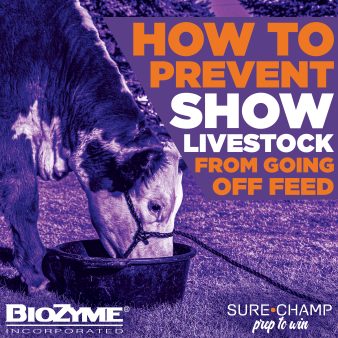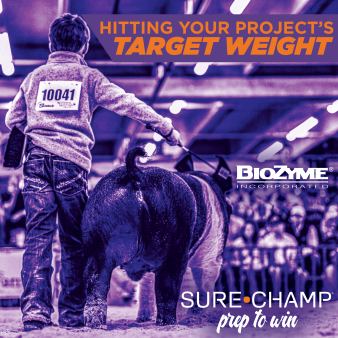
Walk into any feed room in any barn, and what do you see? Rows of neatly stacked bags that look very similar. It doesn’t matter what species you are feeding; the differential is in the brand. One brand might be purple and black, another green and white and another tan and orange; but bag after bag will appear to be the same – on the outside.
Chances are the ingredients on the inside of those bags are different. And that is why it is important for you, the feeder and the exhibitor, to know how to read a feed tag. You’ve filled your show barn with the kind of livestock that you enjoy feeding, working on and showing, so it should be equally important for you to provide those animals with the proper feed and that starts with knowing what’s on that feed tag and in the bag.
Blaine Rodgers, long-time livestock feeder and BioZyme® Inc. Western U.S. ASM and Show Livestock Manager, explains the importance of reading a tag and outlines the four components that each tag includes.
Product name. This seems fairly self-explanatory. However, many products do have similar names, and contain numbers. Be sure to read each name closely. You might even want to sort your feeds by product names or use a Sharpie to write your generic name on each bag.
Medication withdrawal or residue instruction. This information tells you what kind of medication is in the feed and the withdrawal length for that medication. With VFD or Veterinary Feed Directives, these are less common than they used to be, but they do still exist. Rodgers said this is the most important information on the tag because it is your duty as the feeder to pay close attention to this information, especially if feeding an animal for a show or one that is ultimately going into the food supply chain.
Guaranteed analysis. The guaranteed analysis breaks down the amounts of nutrients in each feed. Rodgers cautions that each company lists their analyses differently, and the feeder needs to pay careful attention. He said some companies will list minimums and others will list maximums, so read the tag closely to be sure you are getting the proper amount of a nutrient such as protein, fat or fiber to reach your animal’s optimal potential. A more in-depth guaranteed analysis will also list vitamin and mineral content.
The guaranteed analysis could be the most important part of the tag because you can tell a lot about the feed and how it will play a role toward the type of animal you are feeding. Use protein as an example.
“Higher protein levels generally are targeted toward younger livestock that are in their developmental stage, and trying to increase muscle, bone and skeletal growth. As we get into the later portions of their life, and we’re trying to slow that portion of growth down and increase more of the finishing phase, their protein level will be decreased,” Rodgers said.
In addition to describing the nutrient content of the feed, the guaranteed analysis will also help you determine your feeding rate. For example, if the directions call for 4 ounces of a 5% protein product, that is equal to 2 ounces of a 10% protein product, so it is important to pay close attention to the nutrient breakdown compared to the feeding rate of a particular product.
Ingredient profile. This is the list of actual ingredients that is in the bag of feed, starting with the highest volume ingredient all the way down to the lowest volume, much like the way ingredients are listed on human food. Rodgers notes it is important to realize that all feedstuffs are not created equally. Feed A with 20% protein may not be the same quality as Feed B that also is listed with 20% protein. Both companies might use ingredients that total up to 20% protein, but the chances are that one of them will use higher quality resources that will benefit your animal.
There are few good ways to tell which feed has the higher-quality ingredients. Look for price; you often get what you pay for. Buy from someone you’re comfortable talking to about the ingredients and that you trust will give you an honest answer. Rodgers compares buying feed with buying show animals.
“Sometimes we think all these show feeds are the same and it’s just a marketing effort that changes the level of perception, but that’s not necessarily the case. You can go buy two different show animals from two different breeders. They can weigh the same, be the same breed, all those things, but due to their genetics and management, they aren’t necessarily the same quality. Feed ingredients are the same way,” Rodgers said.
From his experiences living and feeding livestock in various regions of the U.S., Rodgers notes that different states do have different regulations and rules. Some states have to be very specific, listing every ingredient, whereas others can be more general, which might seem disadvantageous to the feed buyer and feeder.
Why it Matters?
Now that you understand what is on a feed tag and in that bag, why does it matter? It matters because that is ultimately going to guide your success as a livestock feeder. You are the person who will know the make-up of your animal, its strengths and weaknesses, and as Rodgers explains, those are what you need to feed to, to make the animal the optimal show prospect.
“A lot of feeding livestock is trying to pick an animal on their parts and feed them toward the middle where you can make things more ideal. If they’re extreme in one area bring them the other direction. If they’re deficient in another area, bring them the other direction,” he said.
So, when it comes to buying feed you need to understand what you need on that tag to make your animal better for the particular phase of its life. Does it need more protein? Less Fiber? Less Protein? More Fat? You will likely know better than whoever is loading the feed in the back of your truck at the local feed store what you need to be feeding, and remember all those bags look similar, so check the tag!
Prep to Win
One way to get the maximum benefit from whichever feed you choose for your show livestock is by adding a supplement with the Amaferm® advantage from the Sure Champ® line EVERY. DAY. Amaferm is a precision prebiotic designed to enhance digestibility by amplifying the nutrient supply for maximum performance. It is research-proven to increase water and feed intake, and research shows that Amaferm decreases body temperature in heat-stressed animals. Sure Champ products to help keep your animals on feed and water and help with overall nutrient intake, digestion and absorption exist for cattle, sheep, goats and hogs.
Get to know your feed tags. Learning what’s on the tag is just the first step to learning what’s in the bag to make your good show animal a great one. Go one step further and #preptowin with a daily supplement from Sure Champ.

